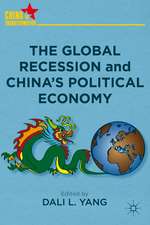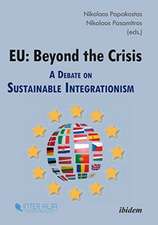The Economics of International Immigration: Environment, Unemployment, the Wage Gap, and Economic Welfare: New Frontiers in Regional Science: Asian Perspectives, cartea 27
Autor Kenji Kondohen Limba Engleză Hardback – 7 oct 2016
| Toate formatele și edițiile | Preț | Express |
|---|---|---|
| Paperback (1) | 779.39 lei 6-8 săpt. | |
| Springer Nature Singapore – 15 iun 2018 | 779.39 lei 6-8 săpt. | |
| Hardback (1) | 785.42 lei 6-8 săpt. | |
| Springer Nature Singapore – 7 oct 2016 | 785.42 lei 6-8 săpt. |
Din seria New Frontiers in Regional Science: Asian Perspectives
- 15%
 Preț: 652.64 lei
Preț: 652.64 lei - 18%
 Preț: 742.00 lei
Preț: 742.00 lei - 15%
 Preț: 645.96 lei
Preț: 645.96 lei - 18%
 Preț: 798.18 lei
Preț: 798.18 lei - 18%
 Preț: 728.74 lei
Preț: 728.74 lei - 18%
 Preț: 724.14 lei
Preț: 724.14 lei - 18%
 Preț: 733.33 lei
Preț: 733.33 lei - 15%
 Preț: 693.25 lei
Preț: 693.25 lei - 15%
 Preț: 640.06 lei
Preț: 640.06 lei - 15%
 Preț: 702.87 lei
Preț: 702.87 lei - 15%
 Preț: 718.61 lei
Preț: 718.61 lei - 18%
 Preț: 786.36 lei
Preț: 786.36 lei - 18%
 Preț: 1110.72 lei
Preț: 1110.72 lei - 15%
 Preț: 644.18 lei
Preț: 644.18 lei - 18%
 Preț: 787.78 lei
Preț: 787.78 lei - 15%
 Preț: 699.45 lei
Preț: 699.45 lei - 18%
 Preț: 897.47 lei
Preț: 897.47 lei - 15%
 Preț: 643.34 lei
Preț: 643.34 lei -
 Preț: 395.25 lei
Preț: 395.25 lei - 18%
 Preț: 892.42 lei
Preț: 892.42 lei -
 Preț: 386.39 lei
Preț: 386.39 lei - 24%
 Preț: 594.43 lei
Preț: 594.43 lei - 18%
 Preț: 900.31 lei
Preț: 900.31 lei - 15%
 Preț: 714.02 lei
Preț: 714.02 lei - 15%
 Preț: 698.62 lei
Preț: 698.62 lei - 24%
 Preț: 632.82 lei
Preț: 632.82 lei - 18%
 Preț: 1244.59 lei
Preț: 1244.59 lei - 15%
 Preț: 644.63 lei
Preț: 644.63 lei - 15%
 Preț: 639.73 lei
Preț: 639.73 lei -
 Preț: 357.81 lei
Preț: 357.81 lei - 18%
 Preț: 1111.53 lei
Preț: 1111.53 lei - 18%
 Preț: 721.33 lei
Preț: 721.33 lei
Preț: 785.42 lei
Preț vechi: 957.83 lei
-18% Nou
Puncte Express: 1178
Preț estimativ în valută:
150.31€ • 156.35$ • 124.09£
150.31€ • 156.35$ • 124.09£
Carte tipărită la comandă
Livrare economică 14-28 aprilie
Preluare comenzi: 021 569.72.76
Specificații
ISBN-13: 9789811000911
ISBN-10: 9811000913
Pagini: 250
Ilustrații: XIV, 243 p. 21 illus., 8 illus. in color.
Dimensiuni: 155 x 235 x 16 mm
Greutate: 0.54 kg
Ediția:1st ed. 2017
Editura: Springer Nature Singapore
Colecția Springer
Seria New Frontiers in Regional Science: Asian Perspectives
Locul publicării:Singapore, Singapore
ISBN-10: 9811000913
Pagini: 250
Ilustrații: XIV, 243 p. 21 illus., 8 illus. in color.
Dimensiuni: 155 x 235 x 16 mm
Greutate: 0.54 kg
Ediția:1st ed. 2017
Editura: Springer Nature Singapore
Colecția Springer
Seria New Frontiers in Regional Science: Asian Perspectives
Locul publicării:Singapore, Singapore
Cuprins
1. Introduction and Summary.- Part I. International Migration and the Economy of the Host Country.- 2. Permanent Migrants and Cross-Border Workers: The Effects on the Host Country.- 3. Legal Migration and Illegal Migration: The Effectiveness of Qualitative and Quantitative Restriction Policies.- Part II. International Immigration and the Labor Market.- 4. International Immigration and Economic Welfare in an Efficiency Wage Model: The Coexistence Case of Both Legal and Illegal Foreign Workers.- 5. Temporary and Permanent Immigration Under Unionization.- 6. The Frequency of Migration and Optimal Restriction Policies.- Part III. International Immigration and the Natural Environment.- 7. Trans-boundary Pollution and International Migration.- 8. Trans-boundary Pollution and Brain Drain Migration.- 9. Pollution Abatement Equipment and International Migration.- 10. Unemployment, Environmental Policy, and International Migration.- 11. Renewable Resources, Environmental Pollution, and International Migration.- Part IV. International Immigration and Economic Integration.- 12. International Integration with Heterogeneous Immigration Policies.- 13. Emigration, Immigration, and Skill Formation: The Case of a Midstream Country.- 14. Can the Economic Partnership Agreements Help the Developed Country with a Decreasing Population?.
Notă biografică
Kenji Kondoh, Professor (Dr.), School of Economics, Chukyo University, 101-2 Yagotohonmachi Showaku, Nagoya, 466-8666, Japan
kkondo@mecl.chukyo-u.ac.jp
Textul de pe ultima copertă
This is the first book that takes a theoretical approach to the effects of international immigration by considering the current economic topics confronted by more highly developed countries such as Japan. Developed here is the classic trade model by Heckscher–Ohlin–Samuelson, McDougall’s basic model of the international movement factor, the urban–rural migration model by Harris–Todaro, and Copeland–Taylor’s well-known model in the field of environmental economics by introducing new trends such as economic integration including free trade and factor mobility between countries at different stages of development. Coexistence of two types of immigrants – legal, skilled workers and illegal, unskilled workers – without any explicit signs of discrimination, transboundary pollution caused by neighboring lower-developed countries with poor pollution abatement technology, difficult international treatment of transboundary renewable resources, the rapid process of aging and population decrease, the higher unemployment rate of younger generations, and the serious gap between permanent and temporary employed workers—are also considered in this book as new and significant topics under the context of international immigration. Taking into account the special difficulties of those serious problems in Asia, each chapter illustrates Japanese and other Asian situations that encourage readers to understand the importance of optimal immigration policies. Also shown is the possibility that economic integration and liberalization of international immigration should bring about positive effects on the economic welfare of the developed host country including the aspects of natural environment, renewable transboundary resources, the rate of unemployment, and the wage gap between workers.
Caracteristici
Focuses on the economic analysis of developed host countries such as the EU countries, Japan, and the United States Treats the connected current topics of global economy such as unemployment, environmental pollution, and economic integration Consists mainly of material published in refereed journals and also includes a survey study of international migration















